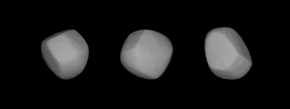167 Urda
 A three-dimensional model of 167 Urda based on its light curve. | |
| Discovery | |
|---|---|
| Discovered by | C. H. F. Peters |
| Discovery site | Clinton, New York |
| Discovery date | 28 August 1876 |
| Designations | |
| (167) Urda | |
| Pronunciation | /ˈɜːrdə/ |
Named after | Urd |
| A876 QA; 1899 KC; 1905 QA; 1906 WA | |
| main belt (Koronis asteroid family) | |
| Orbital characteristics[1] | |
| Epoch 31 July 2016 (JD 2457600.5) | |
| Uncertainty parameter 0 | |
| Observation arc | 132.01 yr (48218 d) |
| Aphelion | 2.9583526 AU (442.56325 Gm) |
| Perihelion | 2.7493497 AU (411.29686 Gm) |
| 2.8538511 AU (426.93005 Gm) | |
| Eccentricity | 0.0366177 |
| 4.82 yr (1760.9 d) | |
| 37.607175° | |
| 0° 12m 15.969s / day | |
| Inclination | 2.212408° |
| 166.21859° | |
| 133.03586° | |
| Earth MOID | 1.73392 AU (259.391 Gm) |
| Jupiter MOID | 2.10867 AU (315.453 Gm) |
| TJupiter | 3.302 |
| Physical characteristics | |
| Dimensions | 39.94±1.9 km |
| 13.07 h (0.545 d) | |
| 0.2230±0.023 | |
| S | |
| 9.1 | |
167 Urda is a main-belt asteroid that was discovered by German-American astronomer Christian Heinrich Friedrich Peters on August 28, 1876, in Clinton, New York, and named after Urd, one of the Norns in Norse mythology. In 1905, Austrian astronomer Johann Palisa showed that the asteroid varied in brightness.[2]
Photometric observations of this asteroid at the Palmer Divide Observatory in Colorado Springs, Colorado, during 2007–8 gave a light curve with a period of 13.06133 ± 0.00002 hours.[3] This S-type asteroid is a member of the Koronis family of asteroids that share similar orbital elements.[4]
In 2002, a diameter estimate of 37.93 ± 3.17 km was obtained from the Midcourse Space Experiment observations, with an albedo of 0.2523 ± 0.0448.[5]
A stellar occultation by Urda was observed from Japan on July 23, 2001.[6]
References
[edit]- ^ Yeomans, Donald K., "167 Urda", JPL Small-Body Database Browser, NASA Jet Propulsion Laboratory, retrieved 12 May 2016.
- ^ Maddrill, James D. (December 1905), "Variable Asteroid (167) Urda", Publications of the Astronomical Society of the Pacific, vol. 17, no. 105, pp. 190–192, Bibcode:1905PASP...17..186., doi:10.1086/121648, JSTOR 40691277.
- ^ Warner, Brian D.; et al. (October 2008), "Shape and Spin Models for Four Asteroids", The Minor Planet Bulletin, vol. 35, no. 4, pp. 167–171, Bibcode:2008MPBu...35..167W.
- ^ Moore, Patrick; Rees, Robin, eds. (2011), Patrick Moore's Data Book of Astronomy (2nd ed.), Cambridge University Press, pp. 164–165.
- ^ Tedesco, Edward F.; et al. (July 2002), "The Midcourse Space Experiment Infrared Minor Planet Survey", The Astronomical Journal, vol. 124, no. 124, pp. 583–591, Bibcode:2002AJ....124..583T, doi:10.1086/340960.
- ^ "Observed Minor Planet Occultation Events - Asteroidal Occultations". Retrieved 14 October 2018.
External links
[edit]- Lightcurve plot of 167 Urda, Palmer Divide Observatory, B. D. Warner (2007)
- Asteroid Lightcurve Database (LCDB), query form (info Archived 16 December 2017 at the Wayback Machine)
- Dictionary of Minor Planet Names, Google books
- Asteroids and comets rotation curves, CdR – Observatoire de Genève, Raoul Behrend
- Discovery Circumstances: Numbered Minor Planets (1)-(5000) – Minor Planet Center
- 167 Urda at AstDyS-2, Asteroids—Dynamic Site
- 167 Urda at the JPL Small-Body Database
